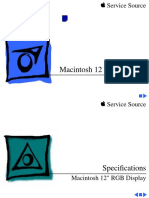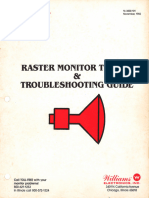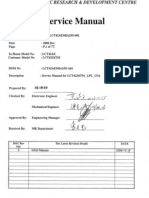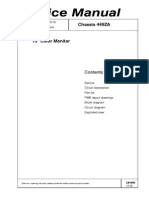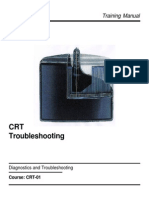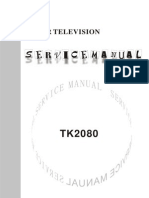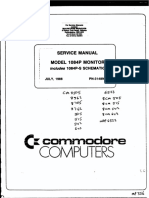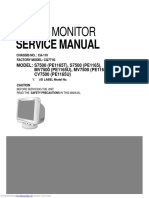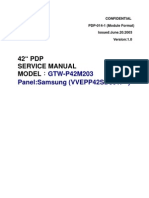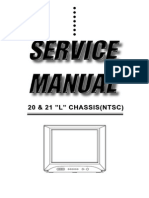0 ratings0% found this document useful (0 votes) 310 views21 pagesCommodore 1802 Monitor
Commodore 1802 Monitor SERVICE Manual
Copyright
© © All Rights Reserved
We take content rights seriously. If you suspect this is your content,
claim it here.
Available Formats
Download as PDF or read online on Scribd
SERVICE MANUAL
MODEL 1802 MONITOR {NTSC}
SEPTEMBER, 1986 PN-602155-85
= commodore
COMPUTERS�INSTALLATION AND CHASSIS PARTS LOCATION
ac
INSTALLATION OF THIS COLOR MONITOR CHASSIS AND INITIAL CHECK POINTS
When installing this color monitor'chassis. first check operation on a black and white telecast. Check and it necessary, adjust
centering, size. and focus. Observe the picture for proper black and white reproduction (tracking) over all areas of the screen
lonable color shading or fringing should be evident. If shading or fringing is evident, degauss the monitor
instances alter installation, a technician need only degauss the faceplate area and touch-up the static (center) con-
CHASSIS PARTS LOCATION
The de
jaussing Coll should be moved slowly around the front faceplate of the picture tube and around the sides and front
of ihe monitor The coil should then be withdrawn slowly to a distance of at least six to ten feet before disconnecting from the
AC supply
This Monitor chassis is equipped with an automatic degaussing
me the monitor is switched ON after having been OFF for at |
cuit which effectively demagnetizes the faceplate each
ten minutes
Note:
See ‘SERVICE ADJUSTMENT’ on p:
}@ 12 for details of adjusting procedures.
CONTRAST
BRIGHT
V. SIZE FBT: Focus ADJ.
H. POSI
| cele Screen ADJ
SIGNAL INPUT PANEL
2nd ANODE CAP
| | votume CRT SOCKET
| MODE SELECT Sw,
TINT
AC POWER CORD
Fig. 1�a ial q q : q fn f
=] ] ]
‘sw701 Tint Color Bright Contrast \V.Size H. Posi V.Hold
a 601 R550 R509 A235 R220 R901 F904 R305
Input signal R207 ©
a DM : W701 Sub Bright VY
a Trimmer oe
1201
BM cscs B H. HOLD
a BD ¥ uneary
1301 Fu A309
a | feck Q4o2
I R418 cai7
| C426
a I Ratt
\
'
L801 E—— { Pin
1 V.CENT oe Cushion
' Laoz
| R369 hoe
a i ”
! FBT
! a T461
|
a R801 t
Li--4 TSw.4204 i
1801 7801 ! L Focus
a 10813 Screen
Nonisolation 9 “—-~~
a Isolation
a M4120 MAIN BOARD
R565 R BIAS
R572 G BIAS
R578 B BIAS
R446 R DRIVE
a R680 B DRIVE
Fig. 2
NECK BOARD�SERVICE INSTRUCTIONS
CHASSIS REMOVAL (SEE FIGS. 3/4)
1, Remove the five screw
binet, (See Fig, 3)
Pull the rear cabinet about 10cm to the rear.
Remove the rear cabinet
4. Remove so!
securing the rear
grounain en remove the
board fro ee Fig. 5)
5 Remove the second anode cap.
iJ /
| Remove five Screws
‘over of the
er connection of the black wire connecting CRT
6. Remove the connectors as fo!
1) Defiection yoe connector
2) Degaussing coil connector
3) Speaker connec
Remove the
8. Take the c
WS St
of the cabir
9. To install the chassis. repeat the above procedure in reve
order,
Remove Second Anode Cap
|
Remove Solder Connection of
Black Wire from CRT Ground |
Fig. 5
2, Repairing of main oc
shown in Fig. 6.
ssis can be done easily. i! stood�SESS RES SSERSRSERSRE RE REE RRR ES
PICTURE TUBE REMOVAL
In order to remove or replace the picture tube, the chassis
must first be removed. Refer to Chassis Removal procedure.
After the chassis has been removed, proceed as follows.
Remove
Four Screws
PRECAUTIONS FOR REPAIRS
1. Check for bad contacts on connectors on the main PC board
and elsewhere by applying hand pressure
Check AC power supply for problems-eg. blown
switch or AC outlet
3. Check for intermittents or defective soldering on the main
board by striking the reverse side of the board gently with
an insulated bar
4, When soldering PC boards, limit soldering iron
temperature to 500°F (200°C) to avoid peeling of the foil
5. When soldering transistors or other semiconductors. use
tweezers or a heat sink clip as shown in Fig. 8 to prevent
heat damage
bad
Loosen the clamping screws on the deflection yoke, purity
and static convergence magnet, and remove them.
Remove four screws securing the picture tube to the front
cabinet
Deflection Yoke
Purity and Static
Convergence
Magnet
Soldering iron
(20 thru 40W}
Fig. 8�SE
TROUBLESHOOTING
‘As major parts of this chassis employ {Cs, defects can often be isolated by referring to the table of symptoms in Table 4.
‘Additional checks of transistor and IC DC voltages and waveforms as shown on the schematic will assist in pinpointing the pro-
blem area. Remember also to check for faulty resi
istors and capacitors, etc. around defective ICs and transistors.
Table 1 IC/TR Failure and Symptoms
: __ tom a ea es TOM a
1201: Video Chroma Circuit Composite/Separate/Monochrome-mode reception
Vert JHoriz. osc.
Drive/Syne. sep.
No picture and poor picture.
No color and monochrome.
Poor color synchronization
Hue discrepancy.
Vertical line only.
No picture, No high voltage.
___ Gireuit | _Unstable picture. -
1301: Vert, output circuit Horizontal line only.
|__ Poor vertical sean
SMPS circuit No. power (No Lamp)
Video interface circuit | No picture or poor picture.
__ switch a: | Incorrect color, i a
1601: Audio amp. circuit |__ve sound er poor sound _ :
001, Video amp. circuit | Composite/Separate mode/Mono
| @00s—a007 : No picture or poor picture _ |
a701: 3.58MHz trap. circuit Composite mode
- : Small dotted stripes appear in the picture |
203: Video drive output circuit Composite/Separate mode/Mono
a a No video or poor video
702: Chroma amp. circuit | Separate mode
- : No color or incorrect color.
201, 0204,
4205 Video sharpness Poor picture :
401: Horiz. drive circutt No picture
a = = _Does not generate high voltage. oa
402: Horiz, output circuit No picture, does not generate
F@202; ABI circuit i
ass3: Blue output circuit t
552: Green output circuit. |
asst: Red output circuit t
high voltage, fuse is blown
Dark or brighter picture,
No blue picture.
Blue with retrace line picture. i
No green picture. 7
Green with retrace line picture
No red picture.
Red with retrace line picture.�TROUBLESHOOTING CHARTS
The following charts are devoted to troubleshooting which. it followed carotully, will assist you in tracking down a faut 10
the collect stage. In order ‘0 utilize the charts (fault trees), firstly eslabl eh ne complaint, ie no raster
Locate the chert apolicable and then oragiess througn the various altematves untii ¢ final black the o“tending comoon
or stage.
1. NO RASTER
CHECK MAIN B+ (123V) ON MAIN PCB.
!
Abnormal
bo _
CHECK F801 (Fuse) CHECK 16.5V LINE OF FBT
—_I
: CHECK/REPLACE Normal Abnormal
OPEN POWER CIRCUIT 1-5
HORIZ. CIRCUIT i aes
REPLACE F80+ CHECK CHECK/REPLACE
+12V LINE Re02, D4Od
eed
CHECK 0801, 0802 |g] REPLACE D801 ! 1 I
D808, D809, j——»| 0802, D808, CHECK/REPLACE STILL :
R801 D809, R801 HORIZONTAL NO RASTER | |
CIRCUIT OF
NORMAL | 1201 (TA7670)
~ CHEGK 1801, NG _ | REPLACE |801. ts
2805, Q806 808, Q808 "ABNORMAL
1 RASTER
: , 1 APPEARS |
: cHeck pace, | NG _ | REPLACE D806, | - i
: T801 T801 a
: CHECK/REPLACE
: OK +123 24V LINE (R822, D303)
: — 485V LINE (R420, 0403)
i CHECK OF FET
HORIZONTAL OUTPUT
CIRCUIT
i
2. NO SOUND
| CHECK SOUND B~ (13.5V1 ON MAIN PCB |
ABNORMAL | NORMAL
jj # — — ee _—- -
CHECK/REPLACE CHECK 1601 NG} REPLACE
807, Rago ——+ PIN 1 (13.5V) | 1601
PIN 10 (KTA720B)
| SOUND wavEFORM) -
ox [os
STILL NO SOUND ——�3. NO PICTURE
CHECK WHETHER THE BRIGHTNESS IS CONTROLLABLE OR NOT
YES | NO
- ——
CHECKUREPLACE cHECK+1a5v LINE |NG_| CHECKIREPLACE
EACH SIGNAL (COMP, SEP. MONO) ON THE CRT DRIVE eee oe circuit
MODE OF INPUT STAGE: O R420, D403, C420,
VIDEO POCESSING PART OF K Gat te O42
001, 005, 006, Qo07
201, 1201 STILL NO PICTURE
i
CHECK/REPLACE
THE EACH PIN OF 1601
(COMP, SEP, MONO MODE)
|
CHECK/REPLACE
THE SIGNAL INPUT
CIRCUIT & BOARD
(2001, Q008, Q006,
007," 1201)
4. NO COLOR (FOR COMP. & SEP MODE)
CHECK COLOR CONTROL
NORMAL COLOR
ADJUSTMENT OF COLOR CONTROL
NO COLOR NO COLOR
— po
| CHECK BAND NG REPLAC!
ADJUST THE COLOR SYNC | e
CAPACITOR (C509) C223, ison 0228, (501
| ;
ok
- '
CHECK IC PIN (18) NG REPLACE
OF 1201 ———~|__ 1201 (T7670)�CHECK/REPLACE SYNC, SEPARATION CIRCUIT AND 1207
7, OUT OF VERTICAL SYNC
CHECK/REPLACE VERTICAL OSC. PART OF 1201
B. OUT OF HORIZ. SYNC
CHECK/REPLACE HORIZ OSC PART OF 1201, AFC CIRCUIT
5. NO VERTICAL SCAN (ONE HORIZ. ONE LINE RASTER)
CHECK/REPLACE R307, R901
OPEN 7 NORMAL
es
CHECK/REPLACE
THE VERTICAL OUTPUT CHECK/REPLACE VERTICAL OUT
CIRCUIT CIRCUIT
REPLACE R326 CMEASURE THE VOLTAGE +24V LINE
sob
CHECK
THE VOLTAGE OF EACH PIN
OF 1301 (uPC-1378H)
ABNORMAL
| NORMAL,
REPLACE 1301 CHECK/REPLACE DEFLECTION
YOKE AND CONNECTION
6. OUT OF VERTICAL SYNC AND HORIZ. SYNC�NS
STATIC CONVERGENCE ADJUSTMENT
A recently developed deflection yoke and electron guns construction has been used on this equipment in combination with
in-line guns and black stripe screen to make a barrel-type magnetic-field distribution for vertical deflection and pin-cushion-type
magnetic field for horizontal deflection with which a self-converging system can be obtained. this type is different from conven.
tional unity magnetic field distribution type deflection yoke. 4-pole magnets and 6-pole magnets are empioyed for static con
vergence instead of a convergence yoke.
1. A crosshatch signal should be connected to the video input terminal of the monitor.
2. Adjust the BRIGHTNESS and CONTRAST Controls for well defined pattern
3. Adjust two tabs of the 4:pole Magnets to change the angle between them (See Fi
vertical lines in the center area of the picture screen. (See Fig. 12 )
4, Turn both tabs at the same time keeping their angles constant to superimpose red and blue horizontal lines at the center
of the screen. (See Fig. 12)
Adjust two tabs of 60-pole Magnets to superimpose rediblue line with green one. Adjusting the angle affects the vertical
lines and rotating both magnets atfects the horizontal lines.
6. Repeat adjustments 3, 4, 5, keeping in mind red, green and blue movement, because 4-pole Magnets and 6-pole Magnets
interact and make dot movement complex.
11) and superimpose red and blue vertical
wo
Dero ADJUST THE ANGLE
ACNE (VERTICAL LINES) CONSTANT
PURITY a.
MAGNETS:
\
ae \
6POLE
MAGNETS 1 a
A ROTATE TWO TABS
\ AT THE SAME TIME
(HORIZONTAL LINES)
Fig. 11 CONVERGENCE MAGNET ASSEMBLY Fig. 13 ADJUSTMENT OF MAGNETS
RED/BLU GRN
ece
J:
REDIBLU ee
GAN- af : te
oe
ace
4-Pole Magnets Movement 6-Pole Magnets Movement Incline the Yoke up Incline the Yoke right
Fig. 12 CENTER CONVERGENCE BY (or down) (or left)
Fig. 14 CIRCUMFERENCE CONVERGENCE
CONVERGENt
VERGENCE MAGNETS Sy oEecue
16
BRST Ra Ea RR ERE RRB eee�See eee ee Bee eee 2 2 2 SE
PRECISE ADJUSTMENT OF DYNAMIC CONVERGENCE (SEE FIGS. 13 AND 14)
NOTE:
This adjustment requires Rubber Wedge Kit
1. Loosen the clamping screw of deflection yoke to allow the yoke to tilt.
2. Place a wedge as shown in Fig. 15 temporarily. (Do not remove cover paper on adhesive part of the wedge.)
3, Tilt front of the deflection yoke up or down to obtain better convergence in circumference. (See Fig. 14) Push the mounted
wedge into the space between picture tube and the yoke to hold the yoke temporarily.
4, Place other wedge into bottom space and remove the cover paper to stick
5, Tilt front of the yoke right or left to obtain better convergence in circumference, (See Fig. 14)
6. Hold the yoke position and put another wedge in either upper space.
Remove cover paper and stick the wedge on picture tube to hold the yoke.
7. Detach the temporarily mounted wedge and put it in another upper space.
Stick it on picture tube to fix the yoke.
8. Alter placing three wedges, recheck overall convergence
Tighten the screw firmly to hold the yoke tightiy in place.
9. Stick 3 adhesive tapes on wedges as shown in Fig. 15.
BLACK AND WHITE TRACKING
The purpose of this procedure is to optimize the picture tube to obtain a good black and white picture at all brightness levels
while at the same time achieving maximum usable brightness. Normai purity adjustment must precede this procedure.
1. Set the Video mode switch to SEP Mode position.
2. Connect the black signal to SEP input terminal
3. Set the brightness and contrast control at the mechanical center position.
4, Rotate the red, green and blue cut off controls fully counter-clockwise.
5. Rotate the G. drive and R. drive controls to midrange.
6
7.
8
Rotate screen VR fully counter-clockwise.
Short circuit G and H with a jumper clip to produce a horizontal line
Slowly turn the screen control on FBT clockwise until color (colors) appears faintly on the screen
Adjust each cut-off control so that color becomes lightest and horizontal lines are turned to white color.
10. Remove the jumper clip
11, Receive the white signal
12. Adjust R/G drive controls (R555, 565) 10 produce a hiclite white screen.
13. Set the brightness and picture controls to minimum,
Then, the raster should appear dark
14. Move the brightness control until a dim raster is obtained
45. If necessary, touch-up adjustment of the three cut off contrals to obtain best white uniformity on the CRT screen
16. Set the brightness and picture controls at the mechanical center position. If necessary, adjust the R. drive and G. drive
controls to produce a uniform black and white picture.
DEFLECTION
YOKE
CONVERGENCE
TEMPORARY MOUNTING — RUBBER MAGNET ASS'Y
WEDGE
\
7 pueseR
apHesive WEOGES
GLASS CLOTH
TAPE
Fig. 15 RUBBER WEDGES LOCATION Fig. 16 Picture Tube Neck Components Location
7�SERVICE INFORMATION
REAR CONNECTION PANEL
©
AUDIO IL
Fig. 17 Signal Input Panel
P.C. BOARD LAYOUT
LED PC BOARD
Fig. 18
NECK PC. BOARD.
Fig. 19-b Top View
fit 5
3 ] g QO
ES / : < oer
+ Z & Papen
+e ee ee ae oe oe ee ee�Fig. 20-a Top View (Component Side)�p View (Component Side)�ona MRS 9 ela
ue ©
RE Ba ig)
+
f
iz
ra
Fig. 20-b Bottom View (Solder side)
cate,�sas
don |
| View (Solder side)�CIRCUIT DIAGRAM
vey tice
pros &
* gaol�DIAGRAM
CHASSIS _NO_CM-I20
SCHEMTIC
SN_9978800IC�SCHEMTIC DIAGRAM
CHASSIS _NO_CM-I20�Tel twist
per 3
Unsere 1 u
lgotenr SO
ump Ww 6
EXT CHiN >
TH ot fF
Cerne 1h
VW
Go
cae 0
coo K-13
Cate
iv
roe it
a ly
WV
4
Ww
W
UO pis
AML iS ID = SOrcere Col favs
6 nee), ZU TY
23.6K
Yow — ove-t 23 aa
119K
Ce aH em
Tpty igiurt aT (auay
ayy oo ee
mK
ee
LIK
Leggy were ot TAY
"5
bby, ar py] oe
Luu, OMEP 30 B14
(ouay ] Of
0-
wy oe Ca
a « Fwrr 33 G2
caoy Qav ane) v
a a ure " i
SAY yan ee
(-bbVvxr
Do 2 360 3
| =.
Say mue-P at
JULY
Fore ifoverr
nt
Fv 2A VIP yd
De as
IoVveP 4 Qo
Ph aly :
VIP ut Cw
oh
~ Compe BYP s
Davee
Vive?
row ee
(wee
tg e-P
(nv
gw”
a
14yu 4
De
uov 4
gov *
lie.
(ore *
ee
‘ae
Low Y be
18K
(.06v
.
a
a
a
af
[
i
L
I
I
1�BESS EEE EEE SE SESS SESS
WVYOVIC 49018
[ 2450) wchtona
—
| GATE PULSE GEN
{ =v BU IN
208 —H BLb IN
DI ~ i |
SPEAKER |
|
a 4
aig; a i eavune
SIE oar | t +26 V LINE
1 be 180 V LINE
i Btacx
\souron Tait + are
oP aa + nexrer
|< sone :
|srocus !
ee












